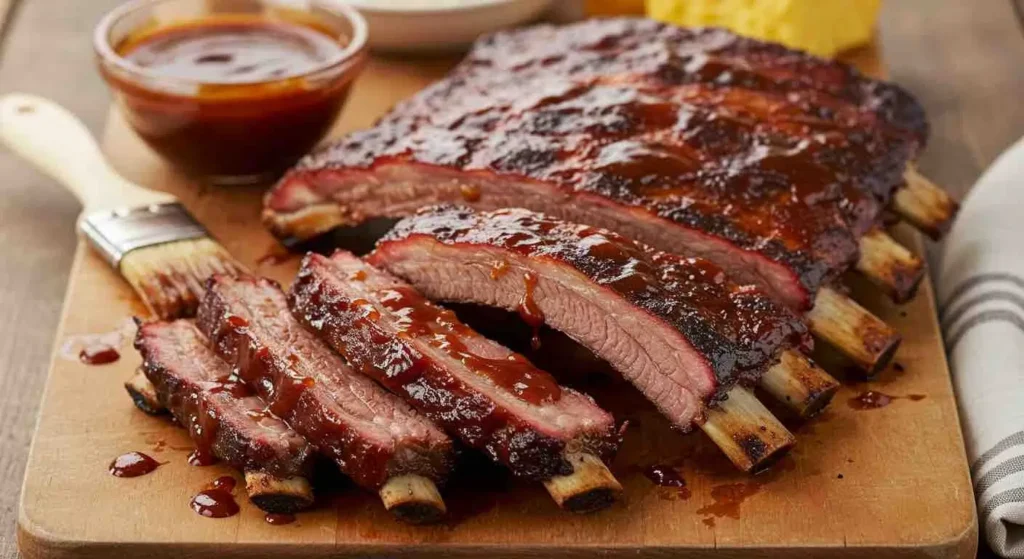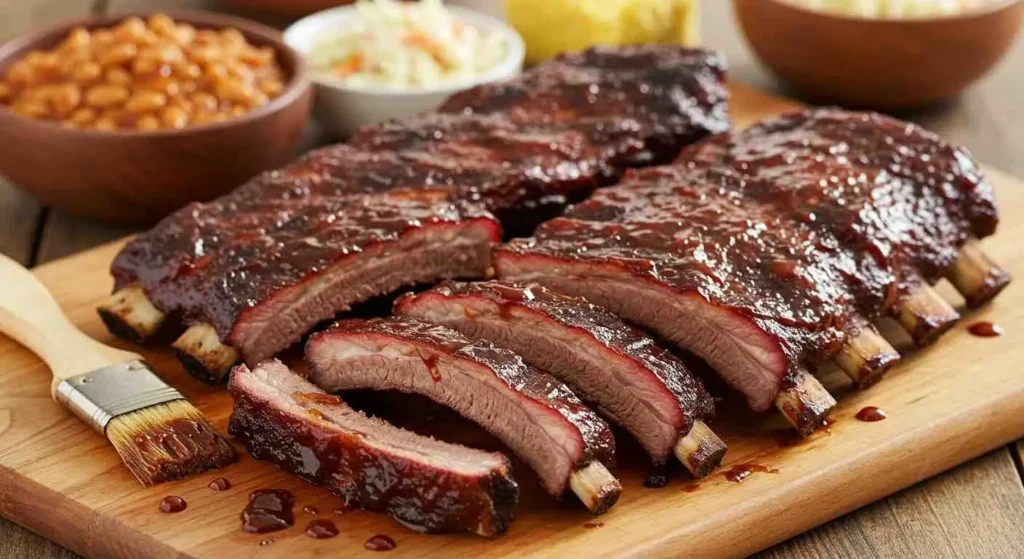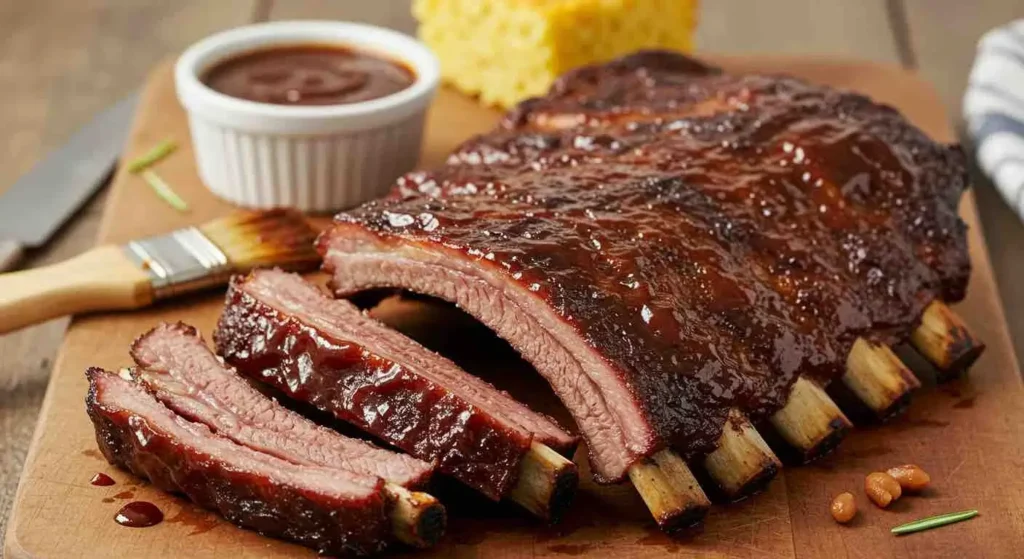Introduction:
Beef back ribs are a flavorful and satisfying dish that can be prepared using various methods to achieve tender, juicy results. Whether you choose to bake them in the oven, grill them, or smoke them, the key lies in slow cooking and proper seasoning. For instance, oven-baked beef back ribs involve seasoning the ribs, wrapping them in foil, and baking at a low temperature for several hours to ensure tenderness. Grilling requires indirect heat and periodic basting to keep the meat moist.
The smell of sizzling beef back ribs always brings back warm memories. Growing up, our family loved to barbecue together. It was a way to share love and tradition through food.
Cooking beef back ribs is more than a recipe. It’s about making moments that bring people closer. This guide will turn your kitchen into a place where amazing ribs are made. You’ll impress everyone with your skills.
We’ll show you how to make restaurant-quality ribs at home. You’ll learn how to pick the right cut and make them tender. This guide will help you succeed in cooking ribs.
Get ready for a cooking adventure that will improve your skills and make meals unforgettable. This guide is for both experienced cooks and beginners. It will teach you how to make beef back ribs that everyone will love.
Table of Contents
Understanding Beef Back Ribs: What Are They?
Beef back ribs are a special cut of meat that meat lovers should know about. They come from the bones left after a prime rib or ribeye roast is trimmed. Despite being smaller, they offer a lot of flavor and can make grilling exciting.
Origin of the Cut
The ribeye roast is removed, leaving the beef back ribs. They come from the upper rib cage, giving them a lean yet tasty meat. Even though they’re a byproduct, they have their cooking charm.
What Makes Them Special
- Lean meat composition
- Intense beef flavor
- Versatile cooking methods
- Ideal for dry rub preparations
Meat Content and Quality
Beef back ribs are leaner than other ribs. They have less meat, which means more intense flavor. The quality of the meat depends on how it’s prepared and cooked.
| Characteristic | Description |
|---|---|
| Meat Quantity | Lower meat yield |
| Flavor Intensity | High |
| Cooking Method | Low and slow smoking or grilling |
When picking beef back ribs, look for vibrant meat color and good fat marbling. Good selection and preparation can turn these ribs into a memorable dish. It shows off the unique qualities of this beef cut.
Pro tip: Back ribs are best prepared using low-temperature, slow-cooking methods to maximize tenderness and flavor.

Essential Ingredients for Perfect Beef Back Ribs
To make delicious beef back ribs, start with the right ingredients. Your rib seasoning and dry rub will turn simple ribs into a feast for the taste buds.
Key Components for Dry Rub
- 2 teaspoons salt
- 1.5 teaspoons smoked paprika
- 1 teaspoon garlic powder
- 1 teaspoon onion powder
- 0.5 teaspoon ground pepper
- 0.5 teaspoon chili powder
- 0.25 teaspoon cayenne pepper (optional)
When making your dry rub, balance is key. The mix of spices adds depth to the ribs’ natural flavor.
Marinade Essentials
A great marinade can take your ribs to the next level. Add apple cider vinegar and a bit of barbecue sauce. Use 1/2 cup of barbecue sauce and 2 teaspoons of apple cider vinegar.
“The secret to great ribs is in the seasoning and preparation.” – BBQ Experts
| Ingredient Category | Purpose | Typical Amount |
|---|---|---|
| Dry Spices | Create flavor base | 2-3 teaspoons each |
| Liquid Marinade | Tenderize meat | 1/2 cup |
| Acidic Components | Break down proteins | 2 teaspoons |
Pro tip: Marinate your ribs with dry rub and braising liquid for up to 24 hours before cooking. This lets the spices soak deep into the meat, making the taste even richer.
Required Tools and Equipment for Preparation
Perfect beef back ribs need special tools and equipment. Whether you’re using a smoker or oven, the right gear is key.
Essential Kitchen Tools
First, collect these important kitchen tools:
- Sharp boning knife
- Cutting board
- Meat thermometer
- Heavy-duty aluminum foil
- Baking sheet
- Tongs
- Meat gloves
Cooking Equipment Options
Your cooking method decides the needed equipment. For rib cooking, you have two main choices:
| Smoker Method | Oven Method |
|---|---|
| Pellet smoker | Large baking pan |
| Hardwood pellets | Rack for elevated cooking |
| Water pan | Aluminum foil |
Optional Enhancement Tools
These items can make your rib cooking better:
- Digital meat probe
- Spray bottle for moisture
- Rib rack for even cooking
- Heat-resistant gloves
Pro tip: Good rib cooking tools make your barbecue better.
Remember, the right equipment is key for a tasty rib-cooking journey.
Preparing the Ribs Before Cooking
Getting your beef back ribs ready is key to a delicious meal. Start by removing the rib membrane and trimming the ribs. This ensures your ribs are full of flavor and tender.
- Rib membrane removal
- Trimming excess fat
- Portioning the rack
Membrane Removal Technique
The membrane on beef back ribs can stop seasonings from getting in and make the meat tough. To remove it:
- Flip the ribs bone-side up
- Use a paper towel to grip the membrane
- Slowly peel it away from the bones
“Proper membrane removal is key to tender, flavorful ribs”
Fat Trimming and Portioning
When trimming ribs, take off too much fat but keep enough for moisture. Beef back ribs usually weigh 6-8 lbs.
| Preparation Step | Time Required |
|---|---|
| Membrane Removal | 5-10 minutes |
| Fat Trimming | 3-5 minutes |
| Total Prep Time | 10 minutes |
Pro tip: You can leave the ribs whole or cut them into individual portions. This depends on your cooking method and serving preferences.

Creating the Perfect Dry Rub Mixture
Turning beef back ribs into a hit starts with a great spice blend. A top-notch rib dry rub recipe can make simple meat into a showstopper. It will wow your guests and excite their taste buds.
Basic Spice Components
Your rib dry rub recipe needs a mix of key spices. The main spices are:
- Paprika (for color and mild sweetness)
- Chili powder (for heat)
- Brown sugar (for caramelization)
- Black pepper (for sharp flavor)
- Cayenne (for additional kick)
- Garlic powder (for depth)
- Salt (for overall seasoning)
Experts say to mix your spices carefully. Use about 1/4 cup of main spices like paprika and chili powder. Add 1 tablespoon of strong spices like cayenne.
Optional Flavor Enhancers
To make your spice blend even better, add special ingredients. Some great choices are:
- Ground cumin for earthy undertones
- Smoked paprika for deeper complexity
- Onion powder for more savory notes
- Dried herbs like thyme or oregano
Mixing and Storage Tips
When making your rib dry rub, mix well for an even flavor. Keep your spice blend in an airtight container in a cool, dark spot. Stored right, it stays strong for up to 6 months.
Pro tip: Use about 2 tablespoons of dry rub per side of your rib rack for perfect seasoning.
Creating the perfect spice blend is an art. Feel free to try different mixes to find what you like best.
The Marinade: Adding Extra Flavor
Making the perfect rib marinade is an art. It can take your beef back ribs from good to amazing. A great marinade tenderizes the meat and adds depth to your dish.
Start by picking the right ingredients for your marinade. Here’s a classic recipe to make your beef back ribs stand out:
- 1/4 cup lemon juice
- 1/4 cup white vinegar
- 1/4 cup olive oil
- 3 tablespoons honey
- 4 cloves of garlic
- 1 tablespoon sea salt
- 1 teaspoon freshly ground black pepper
For a top-notch marinade, balance and patience are key. Marinate your beef back ribs for 12 to 24 hours for the best flavor. Here are some important tips:
- Marinate in glass or plastic containers
- Keep it refrigerated the whole time
- Flip the ribs twice for even coating
“A great marinade doesn’t just add flavor—it transforms the entire eating experience.”
It’s important to store your marinade properly. You can keep leftover marinade in an airtight container in the fridge for up to 5 days. A pro tip: If you plan to use the marinade for basting, boil it for 3 to 4 minutes at medium-high heat to kill bacteria.
| Ingredient | Quantity | Purpose |
|---|---|---|
| Lemon Juice | 1/4 cup | Tenderize meat |
| Olive Oil | 1/4 cup | Add moisture |
| Honey | 3 tablespoons | Create caramelization |
Remember, the right marinade can turn your beef back ribs into a culinary masterpiece!
Temperature and Timing Guidelines
Mastering the art of rib cooking temperature is key to making delicious beef back ribs. Slow cooking turns tough meat into tender, melt-in-your-mouth goodness.
Optimal Cooking Temperatures
For perfect beef back ribs, precise temperature control is essential. Experts say to keep the temperature between 225-250°F (107-121°C). This slow cooking method breaks down the meat, making it tender and flavorful.
- Smoking temperature: 225-250°F
- Grilling temperature: 300-350°F
- Instant Pot cooking: Significantly reduced time of 30-40 minutes
Time Requirements for Perfect Ribs
Cooking times depend on your method, but patience is vital. For traditional smoking, expect 4-6 hours. The internal meat temperature is the best guide to doneness.
| Cooking Method | Temperature | Cooking Time |
|---|---|---|
| Smoking | 225-250°F | 4-6 hours |
| Grilling | 300-350°F | 2-3 hours |
| Instant Pot | High pressure | 30-40 minutes |
Pro tip: The magic happens when the internal temperature reaches 190°-205°F (88°-96°C). This is when the collagen breaks down, creating that fall-off-the-bone texture.
“Low and slow is the secret to remarkable beef back ribs.” – BBQ Pitmaster
Remember to let your ribs rest for 15-20 minutes after cooking. This allows the juices to redistribute, ensuring each bite is succulent and flavorful.
Step-by-Step Cooking Process
Mastering the rib smoking process needs precision and patience. Your journey to delicious beef back ribs starts with careful preparation and attention to detail.
For oven-baked ribs, preheat your oven to 275°F. If using a smoker, keep the temperature at 225°F. The secret to perfect ribs is steady heat during cooking.
- Prepare your cooking surface by placing ribs bone-side down
- Use oak or pecan wood for the best smoke flavor
- Plan for about 40-50 minutes of cooking per pound of ribs
When smoking, cook the ribs for 4-5 hours. For the traditional method, try the 3-2-1 smoking technique:
- 3 hours of initial smoking unwrapped
- 2 hours wrapped in foil
- 1 hour unwrapped with sauce
Aim for an internal temperature of 195°F-205°F for tender, flavorful meat. After cooking, let your ribs rest for 30 minutes. This prevents burns and helps juices redistribute.
“Patience is the secret ingredient in creating perfect beef back ribs.” – BBQ Experts
Whether smoking or oven-baking, the key is consistent temperature, proper seasoning, and enough cooking time. These factors turn your ribs into a delicious dish.
Basting Techniques and Timing
Rib basting is key to making your beef back ribs amazing. It helps keep the meat tender and full of flavor. This makes your grilling results much better.
Creating the Basting Mixture
Your basting mix should be easy to make and taste great. Here are some top picks:
- Classic Vinegar-Based Mop: Mix 1 cup apple cider vinegar, 1/4 cup water, 2 tablespoons Worcestershire sauce, and 1 tablespoon brown sugar
- Cola Mop Sauce: Combine 1 cup cola, 1/4 cup apple cider vinegar, 2 tablespoons Worcestershire sauce, and 1 tablespoon brown sugar
Proper Basting Schedule
Timing is key for basting your ribs. Start basting about 1 hour into cooking. Keep applying your mop sauce every 30-45 minutes.
“The key to perfect ribs is consistent moisture and flavor layering through strategic basting.”
Here are some tips for great rib basting:
- Start basting after the bark forms
- Use a silicone brush for even coverage
- Don’t open the grill too often to keep the temperature steady
The aim of rib basting is to keep the meat moist and add rich flavors. This makes your beef back ribs truly irresistible.
Signs of Perfectly Cooked Ribs
Figuring out when ribs are done is key to enjoying tender, tasty meat. Expert pitmasters use various methods to make sure your ribs are just right. They look for visual and touch signs to check if the meat is tender.
- Internal Temperature Check: Aim for 201°F to 210°F for ideal doneness
- Bend Test: Ribs should crack slightly when bent
- Color Transformation: Look for meat changing from pale pink to reddish-brown
The toothpick test is a trusted way to check if ribs are ready. If a toothpick goes in easily into the thickest part, they’re done. Cooking times differ based on the method. Smoking takes 4-6 hours, while grilling might need only 2-3 hours.
Pro tip: It’s better to slightly undercook than overcook, as ribs continue tenderizing during resting.
| Cooking Method | Temperature | Approximate Time |
|---|---|---|
| Smoking | 225-250°F | 4-6 hours |
| Grilling | 300°F | 2-3 hours |
Remember, mastering rib doneness is an art. Trust your senses and keep practicing to get the perfect technique for tender ribs.

Resting and Serving Methods
Getting your rib resting right is key for a top-notch meal. After cooking, beef back ribs need time to spread out their juices. This ensures the meat stays juicy and flavorful when you cut into it. The resting time varies from 15-30 minutes, based on the meat’s size.
While resting, the ribs will cook a bit more. The inside temperature might go up by 3-4°F for smaller cuts and 10-15°F for bigger ones. To keep the ribs warm and juicy, try these serving tips:
- Tent the ribs with aluminum foil to keep them warm
- Put the ribs in a warm spot in your kitchen
- Don’t cut into them right after cooking
For a stunning presentation, you can serve the whole rack or cut it into portions. Pro tip: Use a sharp knife to cut between the bones for neat, attractive pieces.
“The secret to great ribs is patience during both cooking and resting,” say professional BBQ chefs.
When it’s time to serve, put the rested ribs on a warm platter. Add fresh herbs or a light sauce drizzle for extra flavor and a nice look.
Best Side Dish Pairings
Choosing the right rib side dishes can make your barbecue sides amazing. The perfect side dish enhances the flavor of beef back ribs. It also adds texture and balance to your meal.
Traditional Barbecue Sides
Classic barbecue sides are always a hit. Here are some favorites:
- Potato salad, which can be prepared ahead of time
- Cornbread muffins for easy handling
- Creamy coleslaw that pairs perfectly with meaty ribs
- Baked beans with reduced sugar and salt
Healthier Alternatives for Rib Side Dishes
Looking for lighter options? Here are some healthy choices:
- Loaded Mediterranean sweet potato fries
- Greek chickpea salad that complements any main dish
- Caprese asparagus, ready in just 30 minutes
- Vinegar coleslaw for a vegan-friendly choice
| Side Dish Category | Preparation Time | Flavor Profile |
|---|---|---|
| Classic Potato Salad | 30-45 minutes | Creamy and tangy |
| Grilled Vegetables | 15-20 minutes | Light and smoky |
| Corn on the Cob | 20 minutes | Sweet with herb variations |
When picking your barbecue sides, remember that variety and balance are key. Mix different textures and flavors. This will make your beef back ribs unforgettable.
Storage and Reheating Tips
Keeping your beef back ribs tasty means storing and reheating them correctly. Leftover ribs can be a great snack if you know how to keep them moist.
Here’s how to store your ribs:
- Wrap ribs tightly in aluminum foil or plastic wrap to prevent air exposure
- Store in an airtight container in the refrigerator
- Consume within 5 days for optimal taste and safety
Freezing is great for long-term storage. You can freeze leftover ribs for up to 2-3 months. Thaw them in the fridge overnight before reheating.
Choosing the right reheating method is key. Here are some top ways:
- Oven Method: Preheat to 325°F and reheat for 15-20 minutes
- Air Fryer Method: Heat at 350-400°F for 5-10 minutes
Pro tip: Brush ribs with barbecue sauce or add apple juice to keep them moist. Use a digital meat thermometer to avoid overcooking.
Remember, proper storage and reheating can bring your leftover ribs back to life, making them almost as delicious as when they were first cooked!
Troubleshooting Common Issues
Mastering beef back ribs can be tough, even for experts. Mistakes in prep and cooking can cause problems. This guide will help you fix common issues for tasty results every time.
Addressing Texture Challenges
Tough or dry ribs can spoil your BBQ. The secret to tender ribs is in the cooking temperature and method. Low and slow cooking breaks down tissues without drying the meat.
- Check internal meat temperature carefully..
- Use indirect heat when grilling.
- Allow sufficient resting time after cooking.
Managing Temperature Concerns
Keeping the right temperature is key to rib cooking. High heat can dry out your meat. Aim for a consistent, low temperature of 225-250°F for tender, juicy ribs.
Flavor Adjustment Strategies
Bland ribs are a common issue. To boost flavor, try:
- Using a generous salt and pepper rub
- Experimenting with different spice blends
- Applying marinades or basting sauces
Pro tip: Searing ribs before slow cooking can dramatically improve flavor through the Maillard reaction.
“Cooking ribs is an art that requires patience and attention to detail.” – Barbecue Expert
Understanding these common challenges will help you make delicious beef back ribs. Your guests will be impressed.
Conclusion
Your journey to mastering beef back ribs is a tasty adventure. It’s filled with skill and passion. With the knowledge you’ve gained, you’re ready to make ribs that will wow everyone.
Smoking these ribs needs patience. You should aim for temperatures between 225°F to 250°F. Cooking time is about 5-6 hours.
Remember, making perfect beef back ribs is an art. The ideal internal temperature for tenderness is between 195°F to 203°F. You now know how to pick the right wood and make a great dry rub to bring out the meat’s flavors.
Practice is essential in barbecue techniques. Every time you smoke ribs, you’ll get better at controlling temperature, seasoning, and timing. Feel free to try new wood mixes or spice blends. Beef back ribs are versatile, and you can make each batch special.
Your confidence in cooking will grow with each rack of ribs. Keep exploring and stay curious. Enjoy the journey to becoming a true barbecue master. The most important thing is your passion for making amazing meals that bring people together.
FAQ
What are beef back ribs?
Beef back ribs are what’s left after taking the ribeye roast. They’re lean and come from the cow’s upper rib section. Known for their rich flavor and tender meat when cooked right.
How long does it take to cook beef back ribs?
Cooking time depends on the method. But, it usually takes 4-6 hours with the low and slow method. Smoking at 225-250°F is common, making the ribs tender and flavorful.
Do I need to remove the membrane from beef back ribs?
Yes, removing the tough membrane is important. It lets seasonings get into the meat better. This makes the ribs tender and easier to eat.
What’s the best way to season beef back ribs?
You can use a dry rub or marinade. A classic dry rub has paprika, brown sugar, salt, black pepper, and garlic powder. Apply it well and let it sit for at least an hour before cooking.
How do I know when beef back ribs are fully cooked?
Check with the bend test or internal temperature. Ribs are done at 195-203°F. They bend easily, and the meat starts to pull back from the bones.
Can I cook beef back ribs in the oven?
Yes! You can get great results in the oven. Cook at 275°F. Use a baking sheet with a wire rack for even cooking.
How long can I store leftover beef back ribs?
Store them in an airtight container in the fridge for 3-4 days. Freeze for up to 3 months. Always reheat well before eating.
What are the best side dishes to serve with beef back ribs?
Try classic barbecue sides like coleslaw, baked beans, corn on the cob, and potato salad. For a lighter option, grilled veggies or a fresh green salad are good.
Should I wrap my ribs during cooking?
Wrapping ribs in foil, known as the “Texas Crutch,” helps tenderize the meat. It’s good for oven cooking or speeding up the process.
Can I use the same cooking method for different types of ribs?
While similar, beef back ribs are different from pork ribs in fat and cooking time. Always adjust your method and time for the specific ribs you’re cooking.

